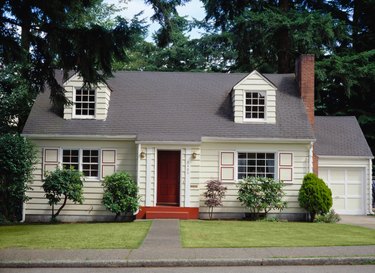 Dormer windows are common on Dutch Colonial homes. Image Credit: Ryan McVay/Photodisc/Getty Images
Dormer windows are common on Dutch Colonial homes. Image Credit: Ryan McVay/Photodisc/Getty Images
Preserving the architectural style of your home means honoring both the design features of the structure and the original materials used to construct the home. For Dutch Colonial homes, this means maintaining the gentle facade and features typical to these homes, while also focusing on materials that were in use when the home was constructed. Materials used on Dutch Colonial homes can vary dramatically based on when the home was built and the materials available near the property.
Video of the Day
Design History
German settlers in Pennsylvania and the Hudson Valley built the first Dutch Colonial homes in the U.S. starting in the 17th century. Some of the remains of these homes, which date back to 1625, can still be found in New York. The Dutch Colonial home design gained popularity because it allowed for nearly an entire second floor of living space without the cost of adding a full second floor. In some areas, this style of home was characterized as a single story rather than a two-story for tax purposes, resulting in lower tax bills for owners who chose this design. Following the 1876 Centennial, the U.S. experienced a major revival in Colonial design styles. Many homes built from the late 1800s through the 1930s were influenced by Dutch Colonial design.
Dutch Colonial Style
Perhaps the most recognizable feature on the Dutch Colonial home is the gambrel roof, which gives the structure a barn-like appearance. The earliest Dutch Colonial homes often contained just a single room, but this design allowed builders to make easy additions to either side of the home to expand living area. Like many other homes of the period, Dutch Colonial homes typically feature a large chimney at one or both ends of the home. Dormer windows are common on the second level, with most windows featuring a double-hung design. Early Dutch Colonials included a central double Dutch doorway, with lower and upper door halves that could be operated independently to keep livestock out while allowing fresh air into the home.
Practical Materials
In 17th century Holland, brick was the most widely used building material for homes. Those settlers who came to the U.S. had trouble securing the traditional brick they were used to building with, so most simply used whatever materials were available to construct their homes. Some relied on the bricks and stones used for ballast during the journey to America, while others used local stone, which could be prepared and stacked or used in a "rubble masonry" technique. Others built homes entirely out of wood, with wooden timbers, clapboards and shingles hewn by hand. The flared eaves on the Dutch Colonial home meant that the front and back walls were largely protected from the weather, and thus could be covered with stucco or plaster. The unprotected side walls were often built from brick or stone in an attempt to withstand the effects of weather. The doors and decorative shutters found on Dutch Colonial homes were often crafted from local timber.
Colonial Revival
By the Colonial Revival period, homeowners had new materials at hand that could be used to construct a Dutch Colonial home. Houses of the Revival period may feature traditional clapboard or wood shingle siding, or walls made from brick or stone. Others took advantage of new materials, with walls clad in modern stucco or composite alternatives. Revival homes used traditional double-hung windows made from wood, though fiberglass or aluminum alternatives may be used on these homes today while preserving the same look. Slate- or wood-shingle roofing was common through World War II; then builders turned to asphalt shingles to save money on roof construction. While wooden doors can still be found on these homes, homeowners may also choose fiberglass or steel for a similar look with less maintenance.



























